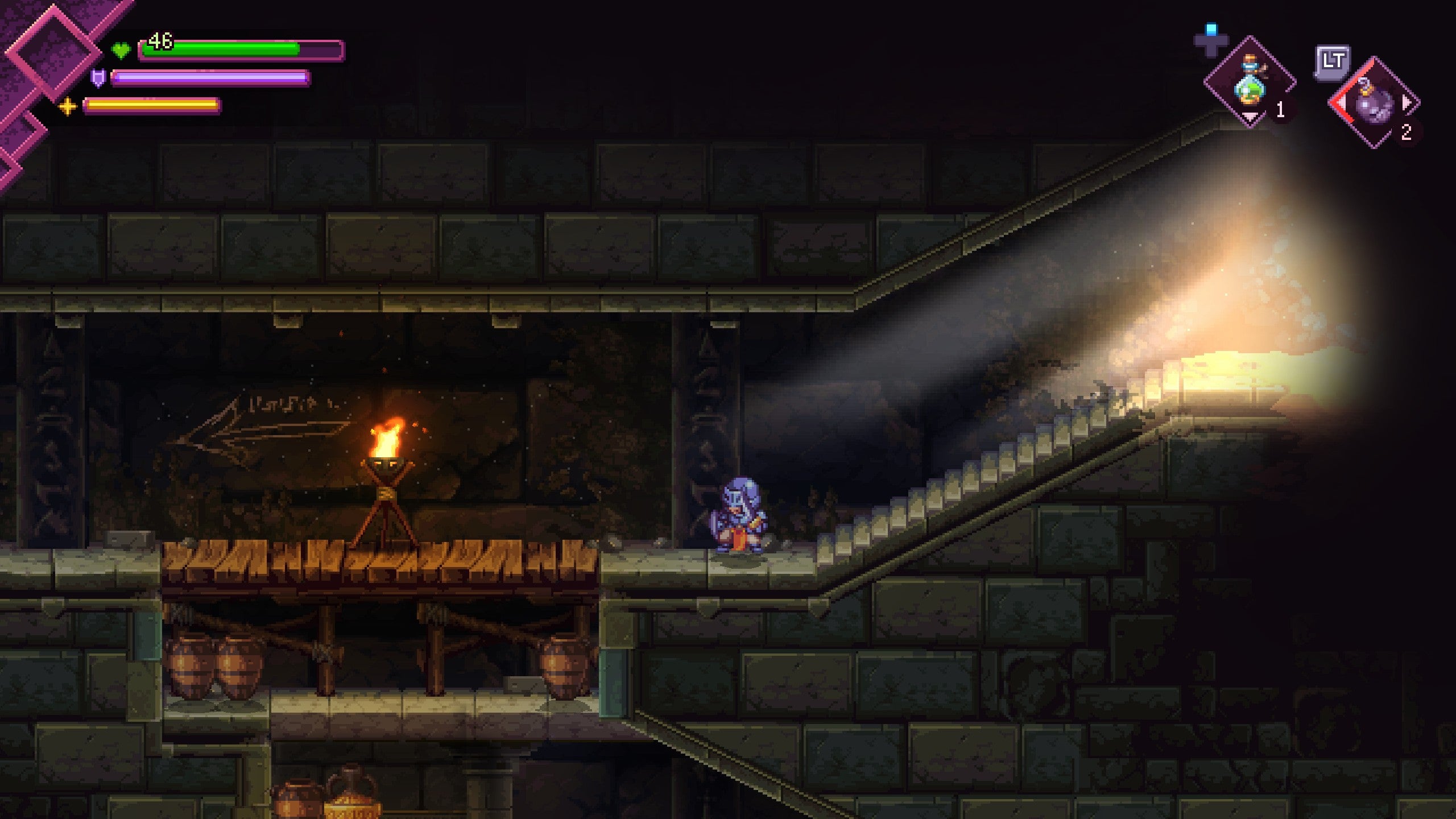Well, I won’t say Souldiers disappointed me. Well, maybe that’s what I want to say. But as a game itself, it’s actually a pretty substantial little piece of software. For one, with Songs of Conquest, it’s arguably the prettiest piece of pixel art in recent memory. My journey through the first area was difficult, but enjoyable. Aesthetically, sonically and in feel, Souldiers is a hit and the hopping and general exploration is a lot of fun too.
But that’s not all. Gradually, I discovered new systems that I would have expected more in a real RPG, which I found extremely interesting at first. And I only played one of three classes, kept forgetting the archer and the magician in between and postponed it to another round. But the further I played, I realized maybe fewer mechanics and clearer direction would have been better for the fun. However, even before the middle of this rather long adventure, Souldiers was actually getting a little tiring.
Between all the elemental states, relics, masteries on the skill tree, and class-specific special moves and short-effect potions, Souldiers aspires to be more of an RPG over time, but its progression feels a little too slow. Nowhere was that clearer than about 20 percent into the campaign: I was level ten, had only unlocked three of the 22 skills on the skill tree, and still had two skill points to award – and couldn’t invest them. Almost all other skills were still locked away behind level locks, for the one that I could have skilled I needed four points. But this isn’t a game you like to grind XP in. That was a damper.
In general, the game bites a little too much into the Souls concept, the role-playing game rubs against the snappy hop. We knew that the level ups were too slow. The opponents take too many hits in the desert region at the latest – does every foot soldier have to give me a hard fight?! – and don’t let successful saves reliably stagger you. Here the fight degenerated into eternal rolling back and forth, in between placing one or two punches, rolling again.

What also prevented the game from really becoming second nature to me: normal attacks, jumps, dodge rolls come to the point exactly when I press the button, but turns and raising the shield are preceded by a small animation. That doesn’t fit in with the rest of the game, which is otherwise so sleek, as does the fact that you can’t block or dodge roll in the air. You’re insanely vulnerable once you lose traction – it doesn’t feel right and makes you lose the habit of jumping in fights…
Before everyone now dismisses the game as a total failure: I think my criticism may seem a little harsher than it should be because I had really high hopes for this little gem and I regret a little that it didn’t become my great love. And yet I think Souldiers will find its fans. Especially if you’re starving for Hollow Knight Silksong, you shouldn’t have a problem with the tough requirement profile and appreciate the general structure of Souldiers – many smaller Metroidvanias divided into classic themed areas, between which you can switch via fast travel.

Personally, I suddenly had a better time when I lowered the difficulty from normal to easy (which unfortunately also disabled some achievements). The game wasn’t even that much easier after that. But the opponents fell faster now, I had the feeling. This made me feel stronger and avoid fights less, which in turn accelerated my progression. The fact that I died less often also reduced my frustration, which sometimes came with having to travel long distances. If everything slips and you wipe the fog off the exemplary map room by room, Souldiers is a retro dream that you rarely get.
From a technical point of view, everything is fine on the PC, but Martin is currently reporting serious concerns on the switch. Souldiers takes an extremely long time to load and stutters on the Nintendo console in a way that’s not very fun. Developer Retro Forge is working on a patch in this regard, if anything changes, we will inform you here. Until then, you better keep your hands off the Switch version.

Souldier’s test – conclusion
These issues are unfortunate, but ultimately only surprising because Souldiers makes such an excellent first impression (check out the Demo on Steam on): The game has heart, an insane amount of charm, and an enticing approach to gameplay that someone seems to have thought about for a long time. Jumping into this is easy. When you then learn that this is Retro Forge’s first game, many of the shortcomings suddenly seem perfectly logical. With these ambitions and the technical and artistic finesse shown, it is basically amazing how neat this debut has turned out.
Maybe there will be a patch or two that will iron out a few of my concerns, make the game less onerous and unleash its full potential. Until then, use Souldiers as a compelling cover letter for the next insider tip Retro Forge might come up with in a few years’ time – or as a vivid reminder of why you were once drawn to this strain of pixel art. Just under 20 euros is not too much to ask for.
Souldiers is available on PlayStation, Xbox, PC and Switch and costs €19.99.
The post Souldiers Test – Not a hollow knight, but a knight with a soul appeared first on Gamingsym.
